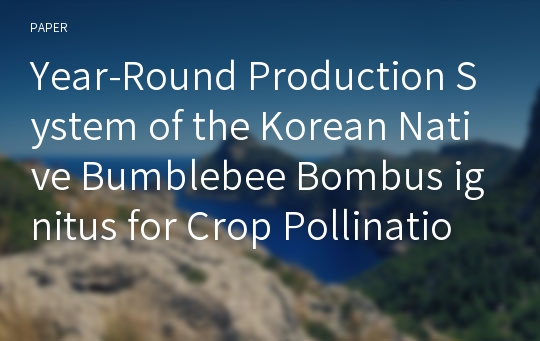Year-Round Production System of the Korean Native Bumblebee Bombus ignitus for Crop Pollination
* 본 문서는 배포용으로 복사 및 편집이 불가합니다.
서지정보
ㆍ발행기관 : 한국응용곤충학회
ㆍ수록지정보 : 한국응용곤충학회 학술대회논문집
ㆍ저자명 : Hyung Joo Yoon
ㆍ저자명 : Hyung Joo Yoon
영어 초록
The bumblebee is an important pollinator of various greenhouse crops, especially for tomatoes and there has been increasing interest in commercial use of the insects for pollination. Recent advances in commercial rearing of the European bumblebee (Bombus terrestris) made it possible to package bumblebee for crop pollination. Bumblebees are distributed world widely including alpine, cool temperate and even arctic environments of the northern continents. We chose B. ignitus out of seven Korean native bumblebees, because the species showed the best results both in artificial multiplication and in pollinating ability. Now, we are studying an artificial year-round mass rearing of B. ignitus selected as the most reliable native species in crop pollination. Therefore, we investigated the optimum temperature and humidity, effect of photoperiod and CO2-treatment, facilitating effects of helper, and artificial hibernation of B. ignitus to establish year-round mass rearing of B. ignius. The experimental regimes of temperature and humidity were defined as 23℃, 27℃ and 30℃ under a constant humidity of 65% R.H., and 50%, 65% and 80% R.H. under a constant temperature of 27℃, respectively. Among the temperature regimes, 27℃-rearing showed the best results, i.e., the rates of colony initiation, colony foundation and progeny-queen production at 27℃ were 83%, 63% and 46%, respectively, which corresponded to 2.2-5.5 times the respective values at other temperature regimes. The numbers of progeny produced at 27℃-rearing, 164±33 workers, 553±174 males and 33±48 queens were also higher, corresponding to 21.8 and 1.5 times those at 23℃ and 30℃, respectively. In terms of humidity, 65% R.H. was favorable for big colony formation. Under the same humidity, the rates of colony initiation, colony foundation and progeny-queen production were 85%, 70% and 50%, respectively, and the number of progenies reached 180±30 workers, 578±179 males and 35±38 queens. Therefore, 27℃ and 65% R.H. were determined to be the favorable environmental conditions for colony development of B. ignitus in indoor rearing. It was investigated whether developmental characteristics of foundation queens of B. ignitus collected in the 4 localities in Korea would be affected by the first oviposition days of them. The first ovipostion day was classified as 1 - 4 days (immediate early), 5 - 6 days (early), 7 - 10 days (delayed early), 11 - 20 days (medium), 21 - 40 days (late), and above 41days (very late). The queen that had the early first oviposition day, i.e., laid eggs so early after starting to be raised indoors, showed much higher rate of colony foundation and progeny-queen production and much shorter period of colony foundation and worker emergence. Besides, the numbers of worker and progeny-queen emerged from the queen that had the early first oviposition day were higher than those of the queen that had the late first oviposition. In results, the queen that had the early first oviposition day could make colony stronger and could make colony formation period shorter, therefore, the first oviposition day of foundation queen was proved to be a criterion for the selection of super colonies when B. ignitus is raised indoors. It was investigated whether or not such helpers as worker bee, bee-cocoon and egg-cup etc, have any effects on oviposition and colony foundation of the bumblebee queen, B. ignitus. Among the helpers tested, the callow workers of B. ignitus and B. terrestris showed the most remarkable effects on the oviposition rates to 92% and 88%, respectively. The live cocoon as a helper improved oviposition rate over 60%. A narcotized old worker 10 days-aged after emergence, showed similar effects to a callow worker on the colony development such as oviposition rate, colony foundation and progeny-queen production. On the other hand, dried cocoon, callow honeybee worker or egg-cup did not show a positive effect as a helper. In the number of workers recruited to a foundation queen, two workers showed better effect than one worker on the colony development, with no difference between two and more. The effect of photoperiodic regimes on the oviposition and colony development of B. ignitus queens was examined with 0L, 8L, and 16L under 2 7℃ and 65% R. H. Among these photoperiod regimes, the oviposition rate at 8L and 16L was 80.2% and 83.1%, respectively, which was 12-15% higher than that at the dark condition (0L). Duration up to first oviposition at 8L and 16L was 17.5 days and 16.5 days, respectively, which was 2-3 days shorter than that at 0L. The colony foundation rate at 8L and 16L was 9.2% and 10.4%, respectively, which corresponded to 1.7-2.0 fold the value at 0L. In addition, the rate of progeny-queen production at 8L and 16L was also two fold higher than that at 0L. Taken there together, the light conditions (8L and 16L) rather than dark condition (0L) were more suitable for oviposition and colony development for B. ignitus in the indoor rearing condition. We investigated mating conditions of photoperiod, illumination and temperature during mating periods, care temperature of queen before mating, mating period and number of queen per mating cage to improve mating rate of B. ignitus. Among photoperiodic regimes of 12L, 14L and 16L during mating periods, queen mated at 14L showed better results than at 12L and 16L in egg-laying characteristics and colony development. In case of illumination during mating periods, intensity of 1000 lux was more effective than at intensity of 100 lux and 2000 lux in mating B. ignitus queen. Mating temperature and care temperature of queen before mating favorable for B. ignitus queen were 22-25? and 19?, respectively. The period need to mating B. ignitus queen was 3 days, and the number of queen suitable per mating cage of 55× 45× 65 ㎝ was 30. The effect of CO2-treatment on interrupting diapause of B. ignitus was examined to provide a means for year-round rearing of the bumblebee. When mated young queens were exposed to 65% or 99% CO2 for 30 min daily during two consecutive days, oviposition rate increased to 75% and 77%, respectively, comparing 50% in CO2-untreated queens. At the same time, the days needed to first oviposition shortened to 17-18 days in CO2-treated queens, comparing to 30 days in CO2-untreated queens. CO2-treatment at the second day after mating was appropriate to the oviposition and colony development. CO2-treatment showed a positive effect on the oviposition and colony development, but less than them of over-wintered queen in numbers of produced progeny. It can be concluded that CO2-treatment to B. ignitus is insufficient to produce commercial grade bumblebee colony in spite of its capability for promoting oviposition, because the treatment failed to form a big colony. Artificial hibernation is essential for year-round rearing of the bumblebee, B. ignitus that undergoes one generation per year. It is known that keeping the queens in low temperature for two or three months is effective to terminate their diapause and develop the colony. Temperature, time and surroundings to keep the queens during artificial hibernation were investigated. Among the tested temperatures, -2.5°C, 0°C, 2.5°C, and 5°C, the optimum temperature was 2.5°C. At the temperature (2.5°C), survival rate after chilling of the queens was high and colony development thereafter was enhanced. The proper time to initiate chilling queen was 10 to 14 days after adult eclosion, and the survivability of the queens after chilling was good during the upper period. For the surrounding to keep the queen during artificial hibernation, we proposed the method to preserve them in a bottle filled with perlite and keep it around 80% R. H.참고 자료
없음태그
"한국응용곤충학회 학술대회논문집"의 다른 논문
 Contents28페이지
Contents28페이지 Biological control of insect pests in Korea: a perspect..5페이지
Biological control of insect pests in Korea: a perspect..5페이지 외래해충 최근 발생현황 및 관리4페이지
외래해충 최근 발생현황 및 관리4페이지 Integrated Management of Oak Wilt Disease4페이지
Integrated Management of Oak Wilt Disease4페이지 Chemicals Relating the Host Selection by the Common Blu..3페이지
Chemicals Relating the Host Selection by the Common Blu..3페이지 Utilization of Microbial Insecticides in Japan5페이지
Utilization of Microbial Insecticides in Japan5페이지 Selecting effective chemical control agents of Bemisia ..6페이지
Selecting effective chemical control agents of Bemisia ..6페이지 Developmental and ovipositional characterisitics of Bem..3페이지
Developmental and ovipositional characterisitics of Bem..3페이지 Chiggers of medical importance in Korea8페이지
Chiggers of medical importance in Korea8페이지 Ticks and tick-borne pathogens: Public health33페이지
Ticks and tick-borne pathogens: Public health33페이지




















